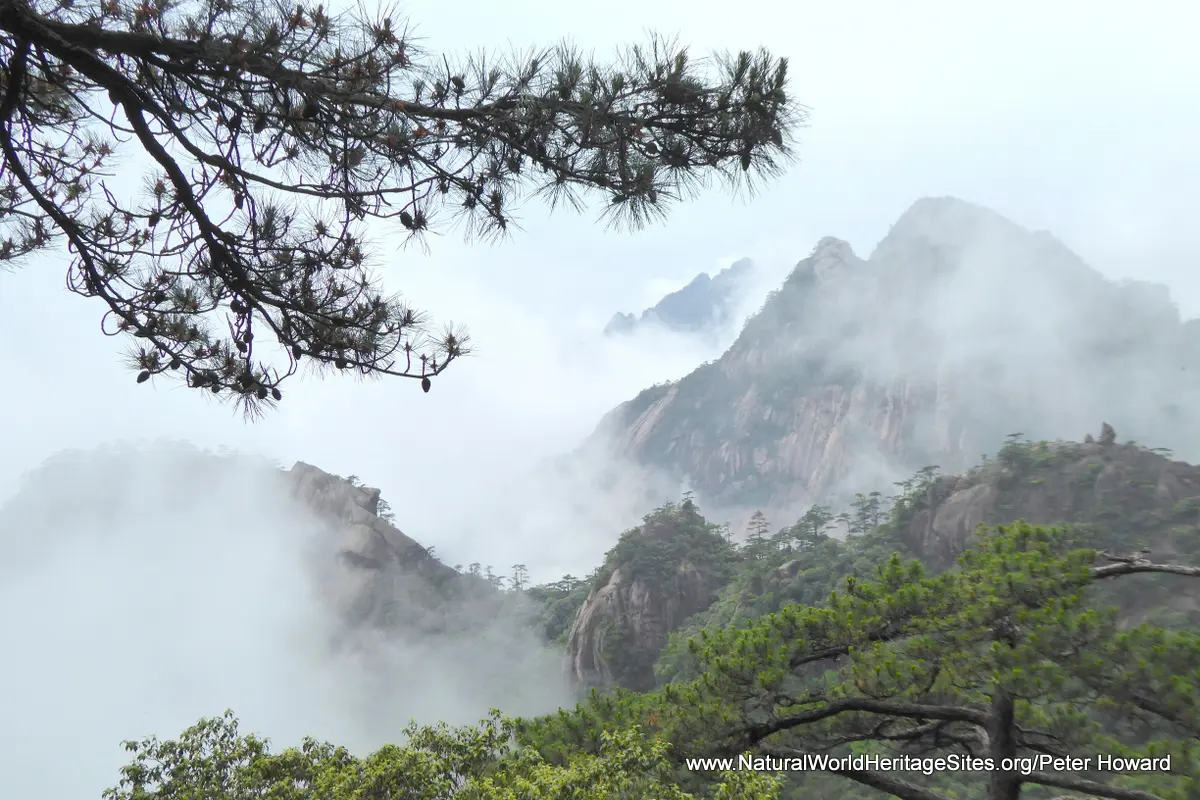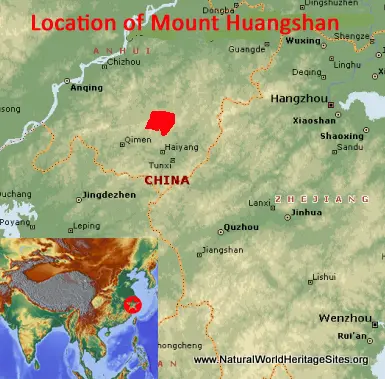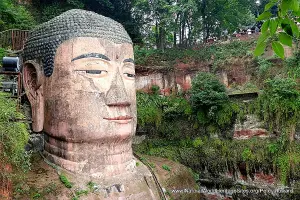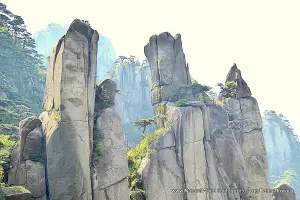EXPLORE CHINA’S MOUNT HUANGSHAN with this slideshow, check the location map and get all the facts and information below
For slideshow description see right or scroll down (mobile). Click to view slideshow
Location and Values: Mount Huangshan was amongst China’s first world heritage sites, and has been described as ‘the loveliest mountain of China’. It is a spectacular, isolated mountain capped with steep granite peaks and dissected by deep gorges, with innumerable granite towers, spires and balancing rocks where gnarled pines cling to life in the most unlikely places. It has provided inspiration for landscape artists, poets, writers and hermits over the centuries and is listed for both its cultural and natural attributes. Although it is a relatively small site it covers a wide range of altitude (from around 500m to 1864m) and supports a correspondingly rich flora with many endemic species. For example, half of China’s fern species are recorded here and a third of its bryophytes (mosses and liverworts).
Conservation Status and Threats. According to IUCN’s most recent Conservation Outlook Assessment (December 2020) the conservation status of Mount Huangshan is considered to be ‘good’. The exceptional values which are recognized by the site’s inscription on the World Heritage List are not seriously threatened, but a number of issues affecting its conservation are noteworthy, including:
- Exceptionally high visitor pressure. Mount Huangshan is renowned as the ‘loveliest mountain in China’, and receives several million visitors each year. There are three cable cars serving the summit area and a number of hotels, restaurants and other facilities at the top of the mountain. The intense tourism pressure is well managed, but continued vigilance is crucial to minimize erosion, protect the vegetation, manage scarce water supplies, waste and sewage without adversely affecting the area’s exceptional mountain scenery and other natural attributes.
- Poor air quality due to atmospheric pollution. The aesthetic value of Mount Huangshan is largely based on far-reaching vistas of its extraordinary rock formations with the contorted forms of ancient trees clinging to rock crevices. These views are significantly affected by a persistent haze of polluted air, arising in urban areas beyond the site boundaries.
- Climate change. The impacts of climate change are not yet fully understood but may already be responsible for a broad range of changes, threatening species and habitats with irreversible change. It is expected that climate change will result in (1) increased fire frequency and intensity due to a general rise in temperatures and increasing drought, (2) increased frequency of severe weather events such as storms, with wind, lightning, rain and snow, which cause rock falls and damage to trees., and (3) possible increases in the populations of alien species, including pathogens. Whilst none of these potential impacts has yet been documented at Mount Huangshan, it is worth recognizing the significance of the threat as the site provides habitat for a number of locally and nationally endemic plant species, several of which are globally threatened.
- Fire. The summit area of Mount Huangshan is particularly susceptible to wild fires due to its dry conditions and shortage of water in the dry season. An alpine fire protection network of artificial water ponds and associated infrastructure is in place to assist in the control of wild fires, but any decrease in water availability due to future climate change is likely to increase this threat.
- Spread of pine wilt disease. This disease is caused by a nematode which is spreading through the pine forests in Mount Huangshan and its surroundings. Action is being taken to control this disease through the establishment of isolation and quarantine stations, whilst monitoring is underway.
Links:
Google Earth
Official UNESCO Site Details
IUCN Conservation Outlook
UNEP-WCMC Site Description
Birdlife IBA
Slideshow description
The slideshow is intended to ‘tell the story’ of Mount Huangshan, and features a portfolio of photos from a visit by Peter Howard in May/June 2017. The slideshow begins with the cable car at the eastern steps, which reduces the steep climb to the summit area to a short 12-minute ride. At the summit the crowded paths connect some spectacular vantage points which look out – through the haze-over the forested valleys below and across to dramatic rock formations around adjacent peaks. Many of the photos in this portfolio are from the ‘West Sea Canyon’, a steep gorge with a particularly high concentration of spectacular rock stacks and formations where a narrow walkway attached to sheer rock faces and through some tight rock ‘squeezes’ allows visitors to experience one of the ‘wilder’ (and less crowded) parts of the mountain. Much of the remaining part of the slideshow covers the ascent of ‘Heaven Capital Peak’ which has to rank amongst the top experiences of a visit to China. The climb is made possible by the construction of steps, carved into impossibly steep rock faces with ropes and handrails provided at critical points. Depending on the weather, it may not be possible to see the route ahead (or the view from the summit) but the experience of such a climb is at least exhilarating.
Factfile
Website Categories: Mountains; Temperate & Boreal Forests;
Area: 161 km2
Inscribed: 1990
Criteria:
- Outstanding natural beauty (vii);
- Significant number of rare, endemic and/or endangered species (x);
- Cultural criterion (ii)





